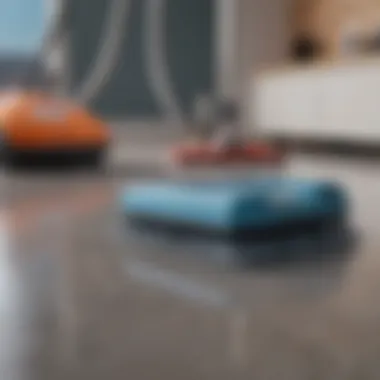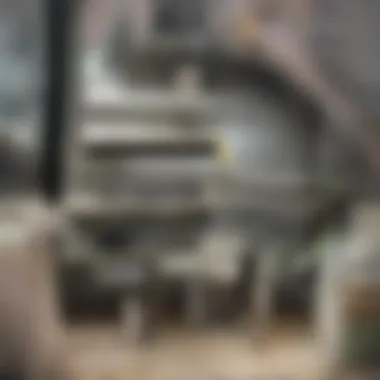Essential Insights on Cleaning Equipment in Housekeeping


Intro
Cleaning equipment plays a significant role in the housekeeping realm. It serves as the backbone of maintaining cleanliness and hygiene in living spaces, ensuring that homes are not only visually appealing but also safe and healthy. In recent years, advancements in technology have introduced a variety of tools, each designed with specific applications in mind. This article will delve into both traditional and modern cleaning equipment, examining their usage, maintenance, and sustainability considerations.
Whether one is a homeowner aiming to instill a sense of order in their environment or an interior decorator seeking to enhance a space's aesthetics, understanding cleaning equipment will be invaluable. Moreover, for real estate enthusiasts, knowledge of cleaning technologies can influence property valuation and desirability. As we navigate through the various types of cleaning tools and their efficacies, it is clear that a comprehensive grasp of cleaning equipment is essential for those invested in maintaining pristine environments.
Exquisite Architectural Designs
As we explore the broader context of cleaning equipment, it is essential to consider how the design of a space impacts cleaning methodologies. The architecture of a home can dictate the types of cleaning equipment that are most effective.
Unique Home Features
Certain architectural elements can complicate or simplify the cleaning process. For instance, homes with high ceilings may necessitate specialized equipment like extension dusters or vacuums with overhead functionality. Conversely, very minimalist designs often require less intensive cleaning tools, favoring quick and efficient approaches.
Historical Significance
Some homes boast historical significance that requires careful preservation efforts. In these cases, specialized cleaning equipment plays a crucial role. Using the right tools prevents damage to sensitive materials while preserving the integrity of the structure.
Effective Cleaning Equipment
Cleaning equipment can be classified into categories based on their functionality. These divide into mechanical devices, manual tools, and chemical cleaning solutions.
Mechanical Devices
- Vacuum Cleaners: These are essential in household cleaning and come in various forms, from upright to robot vacuums.
- Pressure Washers: Ideal for outdoor spaces, they offer deep cleaning services for driveways and patios.
- Steam Cleaners: These utilize steam to disinfect surfaces, making them ideal for kitchens and bathrooms.
Manual Tools
- Mops: They are a traditional cleaning tool, effective for hard floors.
- Brooms and Dustpans: For quick cleaning needs, a broom can effectively gather debris, complemented by a dustpan.
- Microfiber Cloths: These have gained popularity due to their efficiency in removing dust and grime.
Chemical Cleaning Solutions
Selecting the right cleaning product can greatly influence the overall effectiveness of any cleaning task. It is essential to understand which chemicals work best with different surfaces, as misuse can lead to damage. Some common categories include:
- Disinfectants: For sanitizing surfaces in high-use areas.
- All-Purpose Cleaners: Suitable for general cleaning tasks across various surfaces.
"The right cleaning equipment not only enhances cleanliness but also extends the life of furnishings and interiors."
Sustainability Considerations
In an era where sustainability is paramount, choosing eco-friendly cleaning equipment is essential. Many products today are designed with the environment in mind, utilizing biodegradable materials and sustainable production processes. The choice of cleaning equipment can impact not only home hygiene but also the ecological footprint of cleaning practices. By prioritizing sustainable options, homeowners can contribute to a cleaner, greener world.
Finale
Understanding the role and applications of varying cleaning equipment in housekeeping is critical. This awareness aids in making well-informed decisions that align with specific needs. Whether one emphasizes effective cleaning solutions or sustainability principles, the implications of choosing the right equipment extend far beyond mere aesthetics.
Prelims to Cleaning Equipment in Housekeeping
Cleaning equipment plays a pivotal role in establishing and maintaining high standards of cleanliness in any living or working environment. It combines functionality with innovation to ensure the effective upkeep of spaces. When analyzing cleaning equipment, one must consider not only the types of tools available but the approaches to utilizing them effectively. Effective cleaning equipment can lead to a healthier environment by eliminating dust, allergens, and pathogens. This not only improves aesthetics but also contributes significantly to the well-being of occupants.
Defining Housekeeping Standards
Housekeeping standards are a set of guidelines that dictate the expected levels of cleanliness and hygiene across different environments. These standards vary by context; a luxury hotel holds its guests to a higher standard than a private residence. Regulations often stem from health guidelines issued by organizations, ensuring safety and sanitation.
Establishing these standards allows for measurable results. Housekeeping personnel must be well-trained in these standards. In many places, regular inspections are a common practice to maintain compliance. Without these standards, it becomes challenging to quantify cleanliness or uniformity in cleaning practices.
Importance of Effective Cleaning Equipment


Having the right cleaning equipment is fundamental to achieving housekeeping standards. Proper tools enhance efficiency, allowing tasks to be completed in a fraction of the time compared to using inadequate instruments. Consider vacuum cleaners; they have evolved significantly. Modern models can detect dirt levels and adjust suction accordingly, which ensures a thorough cleaning process.
Furthermore, effective equipment reduces physical strain on workers. Heavy-duty mops and ergonomically designed tools lessen the likelihood of injuries associated with repetitive tasks. In this context, the investment in quality equipment is a rational choice. It saves time, enhances productivity, and fosters a positive work environment.
Types of Cleaning Equipment
Cleaning equipment is essential in maintaining cleanliness and hygiene in various environments. Understanding different types of cleaning tools enables one to choose the right equipment for specific tasks. This section will detail manual cleaning tools, mechanical cleaning equipment, and chemical cleaning agents, discussing their benefits and applications.
Manual Cleaning Tools
Manual cleaning tools remain fundamental in housekeeping due to their versatility and ease of use. Their effectiveness often depends on the cleaning method and the surface being cleaned.
Brushes
Brushes are effective for scrubbing and reaching tight spaces where other tools may fail. The bristles can vary in hardness, allowing for use on both delicate surfaces and rough scouring tasks. The adaptability of brushes makes them a beneficial choice for thorough cleaning. Unique features include the various shapes (like handheld or long-handled), which allow users to clean effectively without straining their back. However, the downside is that manual scrubbing can be labor-intensive and time-consuming.
Mops
Mops are vital for cleaning floors, especially when dealing with liquid spills. The key characteristic of mops is their ability to absorb moisture and hold cleaning solutions, which enhances the cleaning process. They are favored for their efficient surface coverage and ease of use. A unique feature is the availability of microfiber mops, which trap dirt more effectively than traditional cloth mops. That being said, they require regular washing, which can become a chore.
Brooms
Brooms are essential for sweeping up dust and debris, making them a staple in most households. The sturdiness of brooms allows them to handle a variety of surfaces, from carpets to hard floors. A distinctive feature is the choice between soft and stiff bristles, which cater for different cleaning needs. Brooms are advantageous as they do not require electricity and can be used effectively without causing much disruption. Nevertheless, they can stir up dust, which may temporarily exacerbate allergies.
Mechanical Cleaning Equipment
Mechanical cleaning equipment automates much of the cleaning process, thus saving time and effort. Their reliance on electricity often limits their mobility but enhances cleaning power.
Vacuum Cleaners
Vacuum cleaners are crucial for removing dust and allergens from various surfaces, particularly carpets. The key characteristic of vacuum cleaners is their suction power, which can vary widely among models. They are popular choices due to their efficiency and ability to reach areas like under furniture. A unique feature of modern vacuums includes HEPA filters, which trap small particles and improve indoor air quality. However, vacuums can sometimes be bulky and challenging to store.
Scrubbers
Scrubbers are specialized machines designed for deep cleaning hard surfaces such as tile or concrete. Their strength lies in the mechanical agitation that enhances the cleaning process. The main advantage of scrubbers is their ability to cover large areas quickly. They often come with different scrubbing pads, making them versatile for various tasks. The trade-off is that they can be expensive and may require specific training for optimal use.
Steam Cleaners
Steam cleaners utilize high-temperature steam to disinfect and clean surfaces without chemicals. Their significant characteristic is the natural cleaning power of steam, making it an eco-friendly option. They are increasingly popular for sanitizing surfaces like kitchens and bathrooms. A unique feature is the variety of attachments that facilitate cleaning different areas, like carpets or upholstery. However, they may not be suitable for all surfaces, and proper care must be taken to avoid heat damage.
Chemical Cleaning Agents
Chemical cleaning agents play a vital role in enhancing the cleaning effectiveness of tools, often targeting stubborn stains or sanitizing surfaces.
Disinfectants
Disinfectants are designed to kill bacteria and viruses, making them critical in maintaining hygiene, particularly in food preparation or medical settings. Their key characteristic is a broad-spectrum effectiveness against various pathogens. Commonly used disinfectants include bleach and hydrogen peroxide. However, they can also be harsh, requiring careful handling and proper ventilation during use.
Detergents
Detergents are essential for breaking down grease and stains in a variety of cleaning applications. They are effective for both hard and soft surfaces, providing versatility. The unique aspect of detergents is the ability to create lather, which enhances cleaning. One major advantage is their ease of access and affordability, while a downside is their potential impact on the environment if not properly disposed of.
Solvents
Solvents are utilized primarily for dissolving other substances, making them useful for heavy grease and paint removal. A key feature of solvents is their rapid evaporation, leaving surfaces dry relatively quickly. They are beneficial in more specialized cleaning tasks but may have health implications due to fume inhalation. The trade-off is their effectiveness versus potential hazards, necessitating careful use and adherence to safety protocols.
Applications of Cleaning Equipment
In the context of housekeeping, the applications of cleaning equipment play a significant role in achieving and maintaining cleanliness across diverse environments. Understanding these applications allows home and commercial space managers to utilize tools effectively and enhance hygiene standards. The benefits range from improved efficiency in cleaning tasks to the promotion of healthier living and working conditions. Factors like surface types and specific cleaning needs influence the choice of equipment, ensuring optimal results with minimal time and resource waste.


Cleaning Different Surfaces
Floors
Floors are a foundational element in any cleaning strategy. They are subject to everyday wear and tear, accumulating dirt, dust, and debris. A key characteristic of floors is their variety, ranging from tile to hardwood, each requiring different cleaning approaches. This article emphasizes the importance of appropriate tools, such as mops and vacuum cleaners, tailored to the specific floor type. An advantage of specialized floor equipment is its ability to prevent damage while ensuring effective cleaning. For instance, a steam cleaner offers deep sanitation without the need for harsh chemicals.
Windows
Windows represent another area where the right cleaning approach is essential. They not only allow natural light into a space but also need regular maintenance to ensure clarity. The choice of equipment, such as squeegees and window vacuums, can significantly enhance the cleaning efficiency. A standout feature of window cleaning tools is their ergonomic designs, which facilitate ease of use. The main drawback might include the time required to properly clean hard-to-reach areas without risking safety or quality.
Upholstery
Upholstery cleaning brings unique challenges, given the diverse fabrics and materials used in furniture. The critical relevance of upholstery in housekeeping stems from its role in aesthetics and comfort. Specific cleaning equipment, like upholstery steam cleaners and vacuums, are beneficial for removing stains and allergens. One significant advantage of using designated upholstery tools is their ability to retain the fabric's integrity while effectively dealing with entrenched dirt or odors. However, it is essential to consider that some fabrics may require specialized cleaning solutions, which may not be universally compatible with all cleaning tools.
Housekeeping in Commercial Settings
Hotels
In hotels, the application of cleaning equipment is crucial to maintaining guest satisfaction and health standards. This sector often demands a higher cleaning frequency, emphasizing the need for efficient and robust cleaning machines. The notable characteristic of hotel cleaning is the balance between thoroughness and speed. Using industrial-grade vacuums and floor scrubbers allows staff to cover larger areas in a shorter period, which is beneficial in high-occupancy environments. However, this might also lead to higher maintenance costs for equipment.
Office Spaces
Office spaces require a systematic approach to cleaning, affecting employee productivity and morale. The key characteristic here is the diversity of materials needing care. This includes thorough cleaning of carpets, desks, and communal areas. Utilizing vacuum cleaners that feature HEPA filters can contribute to a healthier environment by capturing allergens and pollutants. Yet, the frequent turnover in busy offices can lead to wear and tear on cleaning tools, necessitating regular checks and replacements.
Restaurants
Cleaning in restaurants has a direct impact on hygiene and food safety. The specific aspect here is that cleaning equipment must be effective against grease and food stains, requiring high-powered tools like pressure washers and commercial dishwashers. The unique feature of restaurant cleaning is the speed at which tasks need to be performed, often between shifts. While this ensures cleanliness, it can result in a substantial financial investment in cleaning equipment to maintain standards, especially during peak hours.
"The effectiveness of cleaning equipment directly influences the cleanliness and safety of environments, essential for overall well-being."
Best Practices for Using Cleaning Equipment
When discussing cleaning equipment in the context of housekeeping, it is crucial to emphasize the best practices associated with using these tools effectively. Understanding these practices can lead to better results, longevity of the equipment, and enhanced hygiene standards across various environments. The importance of adopting proper techniques cannot be overstated; they not only improve cleaning outcomes but also promote safety and efficiency.
Proper Usage Techniques
Using cleaning equipment correctly is vital. Proper usage techniques involve understanding the appropriate methods for utilizing tools based on the surface and the type of cleaning required. For instance, when using vacuum cleaners, it is essential to adjust the settings based on floor type. Not every setting is suitable for different materials, which can lead to ineffective cleaning or damage to the surface.
Furthermore, following the manufacturer's guidelines ensures that the equipment functions as intended. This includes understanding how to attach and detach parts, when to replace filters, and which cleaning solutions are compatible with each tool. It is beneficial for users to receive training or access guides to familiarize themselves with these aspects, as misuse can lead to subpar results or injury.
Maintenance of Cleaning Equipment
Regular and thorough maintenance of cleaning equipment is paramount. This practice not only extends the life of the tools but also guarantees optimal performance. Maintenance routines can be divided into two main categories: routine cleaning and safety checks.
Routine Cleaning
Routine cleaning refers to the consistent effort of keeping cleaning equipment in good condition. This includes processes like emptying vacuum bags, rinsing mops, and sanitizing brushes after each use.
The key characteristic of routine cleaning is its proactive nature. By regularly maintaining equipment, users avoid buildup of dirt and grime that can hinder functionality. This maintenance practice is especially effective in creating environments that are consistently sanitary, which aligns with the goals of a thorough cleaning regimen. Users find that consistent attention to cleaning their equipment correlates with better cleaning results overall.
Safety Checks
Safety checks involve inspecting equipment for any signs of wear or malfunction before and after use. This procedure includes checking power cords, ensuring proper operation of mechanical parts, and inspecting cleaning agents for expiration dates. It allows users to catch issues before they escalate into more significant problems or potential hazards.
The significant characteristic of safety checks lies in their preventive nature. By implementing regular safety checks, users can greatly reduce risks of accidents during cleaning. This practice supports the overall goal of maintaining a safe environment for both workers and occupants. Additionally, ensuring equipment is in good working order can enhance the effectiveness of cleaning efforts, further improving the standard of cleanliness.
Key Point: Best practices in using cleaning equipment not only enhance cleaning efficiency but also ensure safety and longevity of the tools.
Adhering to these best practices creates a robust framework for effective cleaning in various settings. By prioritizing proper usage techniques and maintenance routines, homeowners, real estate enthusiasts, and interior design aficionados can achieve superior cleaning outcomes.


Sustainability in Cleaning Equipment
Sustainability in cleaning equipment is an essential element of modern housekeeping practices. In the face of growing environmental concerns, it has become vital for maintenance professionals and homeowners alike to adopt eco-friendly practices. The significance of sustainability goes beyond the mere use of biodegradable products. It encompasses the entire lifecycle of cleaning tools, including their production, usage, and disposal, impacting health, environment, and economy.
Effective cleaning does not have to come at a cost to our planet. Sustainable cleaning equipment can improve air quality and reduce the risks associated with harsh chemicals. The aim is to balance efficiency and ecological responsibility, contributing to a cleaner environment.
Eco-Friendly Cleaning Tools
Eco-friendly cleaning tools are designed to minimize ecological footprints while maintaining high standards of cleanliness. These tools often use sustainable materials and are manufactured through processes that reduce waste and energy consumption. Common eco-friendly tools include bamboo brushes, washable microfiber cloths, and biodegradable mops.
Some notable advantages of these tools include:
- Reduced environmental impact: These tools help in minimizing pollution and resource depletion.
- Health benefits: Non-toxic cleaning supplies lessen exposure to harmful chemicals.
- Durability: Many eco-friendly options are designed to last longer, reducing the need for frequent replacements.
Moreover, adopting such tools can inspire a shift in consumer behavior, pushing manufacturers to innovate further towards sustainability.
Reducing Chemical Use
Reducing chemical use in cleaning processes poses significant advantages for both human health and the environment. Many cleaning agents have harsh components that can irritate skin, cause respiratory issues, and contaminate water supplies. By opting for alternative methods, such as natural cleaning agents like vinegar and baking soda, users can maintain effective sanitation without endangering health or the ecosystem.
Key strategies to reduce chemical use involve:
- Training staff: Educating housekeeping teams on the benefits of using eco-friendly products can significantly impact chemical consumption.
- Product selection: Opting for cleaners that are certified as environmentally safe ensures a reduced chemical load in homes and businesses.
- Innovative technologies: Utilizing devices like steam cleaners helps in achieving cleanliness without the need for chemical agents.
In summary, prioritizing sustainability in cleaning practices not only enhances hygiene but also promotes a healthier environment. As awareness increases, it is imperative that both consumers and businesses consider sustainable practices not just as an option but as a necessity.
The Future of Cleaning Equipment
The future of cleaning equipment is vital as it shapes how housekeeping is performed in various environments. Advancements in technology signal a shift toward more efficient, effective, and sustainable cleaning solutions. This section looks into innovative cleaning technologies and trends that are likely to define housekeeping in the years to come.
Innovative Cleaning Technologies
Robotics
Robotics in cleaning equipment focuses on automating routine tasks and enhancing efficiency. Robotic vacuum cleaners like the iRobot Roomba are notable for navigating various surfaces automatically. This technology significantly reduces the time spent on cleaning. In addition to convenience, these devices can be programmed or controlled via smartphone, allowing for greater flexibility in scheduling. However, a drawback includes their initial cost, which can be higher than traditional cleaning tools.
Smart Devices
Smart devices are becoming increasingly integrated into cleaning practices. This includes appliances like the Ecovacs Deebot, which connects to home networks for seamless functionality. The key characteristic of these devices is their ability to communicate with users and adjust cleaning patterns in real-time based on environmental factors. They also enhance user experience through automation and remote control features.
Advantages of smart devices include real-time monitoring and customized cleaning schedules. On the downside, reliance on technology means a potential learning curve for users who may not be as tech-savvy.
Trends in Housekeeping Efficiency
Housekeeping efficiency is evolving through new methodologies and technologies. One trend is the increased use of multi-functional cleaning equipment. For instance, a device that cleans, sanitizes, and dries surfaces can save time and labor costs. Additionally, automation is promoting standardization in cleaning practices, ensuring more consistent outcomes.
Another prominent trend is the increasing focus on health. Equipment designed to capture allergens and pollutants is becoming essential, especially in urban living spaces. Higher awareness of hygiene can lead to a greater emphasis on purchasing advanced cleaning devices.
With the blend of new technologies and practices, the future of cleaning equipment highlights a strong shift toward smart, efficient, and sustainable solutions. As these advancements continue to grow, they will reshape how cleanliness is maintained across various environments.
Closure
The conclusion serves as a crucial element in this article as it ties together the various threads discussed regarding cleaning equipment in housekeeping. It emphasizes the importance of selecting the right tools to achieve a high standard of cleanliness. In today’s fast-paced world, every detail counts, especially when it comes to the environments we inhabit. A propensity for cleanliness not only protects health but also enhances aesthetics and overall well-being.
Summarizing Key Insights
Throughout this article, we have examined how cleaning equipment ranges from manual tools like brushes and mops to advanced mechanical devices such as robotic vacuum cleaners. Each type of equipment serves distinct roles in ensuring efficiency and effectiveness in cleaning different surfaces. The resilient nature of various chemical agents parallels technological advancements, showcasing how modern solutions are developed to tackle unique cleaning challenges.
Moreover, we emphasized best practices, including proper maintenance techniques that prolong the lifespan of cleaning equipment and ensure optimal performance. An awareness of sustainability introduces an additional layer to our analysis, as eco-friendly tools become increasingly relevant amidst rising environmental concerns.
"The choice of cleaning equipment can significantly affect overall efficiency and hygiene metrics," is a sentiment echoed by industry experts.
Call for Continued Innovation
Real estate enthusiasts and interior design aficionados should remain vigilant about emerging technologies in the market. Cleaner homes and environments are achievable outcomes when we embrace advancements in tools and practices. The dialogue around cleaning equipment must continue to evolve, keeping pace with innovations that promise greater ease and effectiveness in housekeeping.















